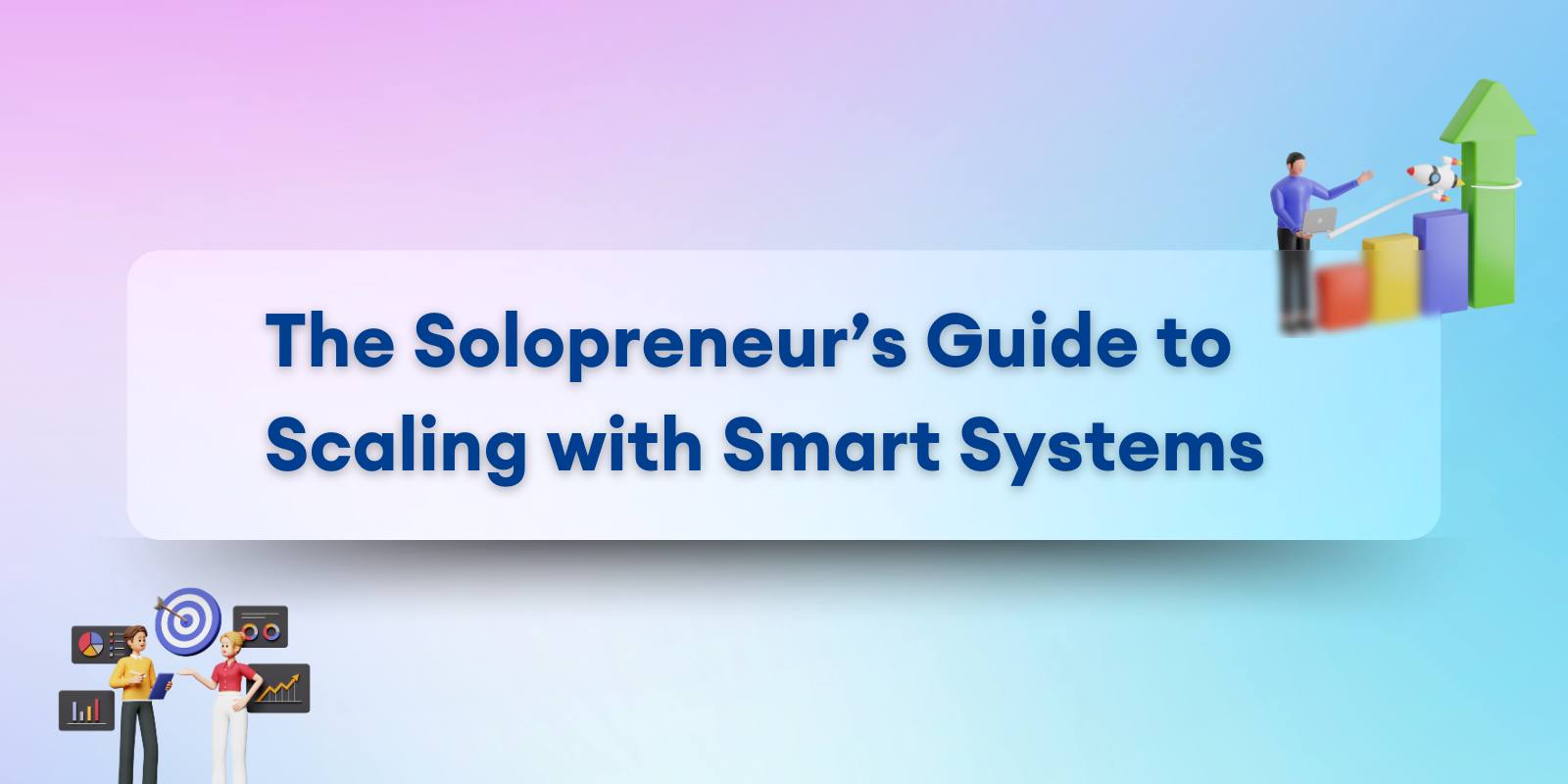
Let’s be real for a second.
You didn’t start this business because you love juggling spreadsheets, chasing freelancers, or recording the same Loom video for the fifth time.
You started because you had an idea worth building.
But somewhere along the way, the dream of freedom turned into an endless cycle of doing, fixing, and redoing.
If you’re running things solo, your days probably look like this:
A freelancer messages you asking how to post the weekly newsletter. You dig up a half-written doc from two months ago. You rewrite instructions. You record a quick video.
By the time you finish, you’ve lost an hour and your focus.
Tomorrow, someone else will ask the same thing.
And it’s not that you don’t want help. You do. You just don’t have the time or headspace to teach the same lessons again and again. So, you start thinking: Maybe it’s easier if I just handle it myself.
That’s the quiet trap every solopreneur falls into.
It doesn’t look like failure. It looks like control.
But what it really is, is a slow leak of your time and creative energy.
Here’s the truth most people won’t tell you:
Doing everything yourself isn’t heroic. It’s expensive.
Not in dollars, but in opportunity. Every hour you spend repeating instructions is an hour you’re not building, selling, or growing. It’s how great ideas stall out before they ever get the chance to scale.
This isn’t a motivation issue. You’re not lazy or undisciplined.
You’re simply stuck in a system that rewards effort instead of efficiency.
And that’s what this article is about: how to flip that system.
Because the real shift doesn’t start when you hire more people.
It starts when you stop running your business from your head and start building one that runs on systems.
Why Solopreneurs Need Systems, Not Staff
Here’s something nobody tells you when you go solo:
Hiring without systems doesn’t make things easier. It makes them louder.
You add more conversations, more questions, more moving parts, but not necessarily more progress. You bring in help hoping for relief, and somehow end up spending twice as much time explaining how to do the work you already know by heart.
That’s not growth. That’s multiplication of chaos.
Here’s the thing most solopreneurs eventually realize: you don’t actually need more hands. You need fewer decisions.
And that happens when you stop relying on people to remember things and start relying on systems to hold them.
Systems don’t get tired. They don’t forget. They don’t message you at midnight asking for that file again.
They take what’s already working inside your head, your way of doing things, and turn it into something repeatable. Something that runs, even when you’re not around.
That’s where an LMS for a small business quietly changes the game.
It’s not just corporate training software. It’s a central place where you can store how your business works, from onboarding checklists to marketing SOPs, and make that knowledge accessible to anyone you bring in, whenever you need them.
Imagine this: you hire a freelancer tomorrow. Instead of another week of back-and-forth DMs, they log into your training hub, go through your short modules, and within a day, they’re doing things your way. No micro-managing. No endless explanations.
That’s the power of a system. It gives you leverage, not labor.
When you start thinking in systems, every hire, every tool, every process becomes easier.
You stop operating like a one-person army and start building like a company of one with structure.
And that shift?
It’s the dividing line between solopreneurs who stay stuck and those who scale sustainably.
Next, let’s talk about why the real issue isn’t your training or your team, it’s the knowledge chaos quietly slowing you down.
The Real Problem Isn’t Training. It’s Knowledge Chaos
If you’ve ever had to stop mid-task just to dig up a link, rewatch an old Loom, or scroll through Slack to find that “one message with the instructions,” you already know the feeling.
It’s not that your team isn’t capable. It’s that your knowledge is scattered across a hundred places, and every time you need it, it costs you another chunk of your day.
What you’re fighting isn’t inefficiency. It’s knowledge chaos.
You’ve got one process in Notion, another in Google Drive, and a third living in your head. There’s no single source of truth, just a web of reminders, checklists, and saved tabs. It works fine when it’s just you. But the moment you bring in help, that setup falls apart.
Let’s break down how this chaos quietly drains your momentum.
When Every SOP Lives in a Different Tab
Your standard operating procedures, if they even exist, are buried somewhere between client folders and screenshots. You tell yourself, “I’ll organize it later,” but later never comes.
So each time you hire someone new, you start from scratch.
You record new videos. Rewrite the same instructions. Re-explain the same context.
You’re not training your team, you’re re-teaching your business, over and over again.
And that’s why you’re stuck in a cycle of temporary fixes instead of scalable solutions.
Why Ad-Hoc Training Keeps You Stuck
When your “training process” is just you answering questions in real time, everything depends on your availability.
You become the bottleneck for every task.
It’s not sustainable, and it’s definitely not scalable.
Ad-hoc training might feel faster in the moment, but it’s the same as patching a leaky pipe with tape. It buys you time, but it doesn’t solve the problem.
Your brain stays overloaded, your energy drained, and your growth throttled by constant reactivity.
The System Shift That Frees Up Your Brain
When you finally centralize your business knowledge - when everything you’ve learned, refined, and documented lives in one place - you don’t just save time. You reclaim mental bandwidth.
Instead of remembering everything, you just point to where it lives.
Instead of reacting to questions, you start anticipating them.
That shift is quiet but powerful.
It’s the difference between running a business that depends on you and building one that runs because of you.
“Your knowledge isn’t your edge if it’s scattered, it’s your liability.”
Once you recognize that chaos for what it is, the fix becomes clear: structure.
And that’s exactly what we’ll unpack next, how smart training systems turn that chaos into pure leverage.
How Smart Training Systems Turn Chaos Into Leverage
Here’s the thing about chaos, it doesn’t happen overnight.
It creeps in slowly, every time you save a file in the wrong folder, skip documenting a task, or forget to update a process you promised you’d “get to later.”
At first, it’s manageable. Then one day, your to-do list is longer than your week, and you can’t tell if you’re growing or just surviving.
That’s when systems become the difference between running a business and being run by it.
The Chaos Curve
Imagine a curve that represents your growth.
At the start, the line rises, every new client, every new project feels like momentum. But as your workload grows and your systems don’t, the curve steepens. You start spending more time managing work than doing it.
Now picture another line, the one that flattens the chaos. That’s what happens when you start documenting, organizing, and systemizing the way you train, delegate, and repeat tasks.
The curve evens out. Growth stops feeling heavy.
That’s what smart training systems do, they flatten your chaos curve.
They don’t just store information. They create consistency, speed, and clarity that multiply every hour you invest.
Simplify and Centralize Everything You Teach
Every time you explain how to do something, record it once and make it easy to find.
That’s the core of a training system, not a giant library of tutorials, but a single home for how your business works.
“Train once. Reference forever.”
Imagine logging into one space where every freelancer or collaborator can instantly access how your marketing, content, or operations are done. No follow-up messages. No “Hey, where’s that doc?” threads. Just quiet clarity.
You stop managing. You start leading.
Onboard Like a Pro Without Being There
If you’ve ever hired someone and thought, “It would’ve been faster to just do it myself,” you’re not alone.
Onboarding is one of the biggest drains for small teams, not because the tasks are hard, but because they’re repetitive.
When you systemize your onboarding, that changes.
Each new person goes through the same set of short, organized lessons, your exact way of doing things. They finish confident and capable, without needing constant check-ins.
“Consistency isn’t corporate, it’s how small teams look bigger than they are.”
This isn’t about replacing personal connection. It’s about setting standards so your brand always feels the same, no matter who’s helping behind the scenes.
Track Progress Without Micromanaging
You don’t need to hover to know what’s happening.
When your systems show who’s completed what, you get a clear picture of progress without constant messages or updates.
Visibility builds trust.
You stop chasing updates and start coaching outcomes.
A simple completion tracker inside your training setup can tell you more about your team’s readiness than a week of status meetings ever could.
Create a Culture of Self-Learning
The most valuable thing systems give you isn’t order, it’s ownership.
When people have access to what they need, they stop asking and start acting.
That’s how you build a self-reliant team, even if your “team” is just one or two freelancers helping you part-time.
“You don’t scale by doing more. You scale by needing less oversight.”
Systems create independence. Independence creates momentum.
And momentum is what separates a business that runs from one that grows.
Smart training systems don’t just clean up your operations.
They buy you back your most precious resource: mental space.
And with that space, you can finally do what solopreneurs do best - build, create, and grow without the noise.
Next, let’s talk about what happens when that shift takes hold, the real freedom that comes when your systems start doing the heavy lifting for you.
The Freedom Effect: When Systems Work So You Don’t Have To
There’s a quiet moment that every solopreneur hits after putting their systems in place.
It’s not dramatic. No champagne corks or viral launches.
It’s the moment you realize your business ran smoothly while you stepped away.
A client got their deliverable.
A freelancer finished a task.
A new hire completed onboarding, all without you checking in.
That’s the freedom effect.
It’s not about working less. It’s about working lighter.
You stop carrying every detail in your head.
You stop firefighting.
You stop feeling guilty for taking a day off.
Because your business finally works like a system, not a scramble.
When you reach this point, growth starts to feel different.
Before, it looked like adding more to your plate.
Now, it looks like your plate staying the same size while your results multiply.
You make fewer decisions because your systems already decided.
You manage fewer people because your processes manage the flow.
You spend more time in creative work, the kind that moves your business forward, and less time catching up on operational chaos.
“When your systems start doing the heavy lifting, you stop managing and start multiplying.”
That’s the moment solopreneurs evolve from doers to builders.
And that evolution doesn’t just change your business. It changes how you see your time, your priorities, and your role in the bigger picture.
You’re not the engine anymore. You’re the architect.
The irony is that freedom doesn’t come from letting go of structure, it comes from creating it.
And if that sounds big or complicated, it’s not.
It starts with small steps, one documented process, one reusable workflow, one less task on your plate tomorrow than today.
Next, we’ll walk through how to start small and build systems that actually stick, even if you’re doing it all on your own.
How to Start Small (and Smart) With Systems That Stick
Here’s the good news: you don’t need new tools, a big team, or a “perfect setup” to start building systems.
You just need a repeatable rhythm, a way to stop solving the same problem twice.
The trick is to start simple and start now.
Start With What You Already Have
Don’t overthink it.
Your first “system” doesn’t have to be some polished platform. It can be a shared Google Drive folder. A Notion page. Even a simple checklist.
The goal isn’t to make it pretty. The goal is to make it clear.
Create one space where all your recurring tasks live.
That’s it. That’s your foundation.
The next time someone joins your project or asks how to do something, you’ll have a link, not a new conversation.
“Tools don’t make the system. Clarity does.”
That’s where efficiency starts: by deciding once and documenting it.
Record, Don’t Repeat
If you find yourself explaining the same thing more than twice, record it once and call it a lesson.
Use Loom, your phone, Zoom, whatever’s fastest.
The point isn’t production quality. It’s consistency.
You can refine later. But every minute you invest in recording today will save you hours down the road.
Think of these recordings as your future clones - small, digital versions of you teaching the exact way you want things done.
Add Layers Only When Needed
Most people go wrong here.
They over-engineer from day one - fancy platforms, complex workflows, endless templates.
Don’t.
Start small, stay small, then expand only when you’re outgrowing your setup.
Once your operations feel stable, that’s when you can graduate to something more advanced, like a lightweight LMS or automated training system.
But for now, focus on habits, not tools.
Because no software can fix what you haven’t clarified.
When you start with small, simple systems, you build trust with yourself.
You prove that structure doesn’t box you in, it sets you free.
Soon, you’ll start noticing the change:
Fewer questions.
Fewer fires.
Fewer “let me explain this again” moments.
That’s when you know your business is growing with you, not against you.
And from there, something bigger starts to shift, not just in your workflow, but in your mindset.
Let’s close this out by talking about that final, crucial shift: the one where your business doesn’t just run smoother, it starts to train itself.
The Mindset Shift. Building a Business That Trains Itself
At some point, every solopreneur realizes that growth isn’t about doing more.
It’s about doing less better.
You start by chasing momentum, taking every project, solving every problem, trying to keep up.
But the real magic happens when you slow down long enough to build the systems that make speed possible.
That’s when your business shifts from something you run to something that runs itself.
It doesn’t mean stepping back. It means stepping into a new role; from doer to designer, from operator to architect.
Because systems aren’t here to replace your creativity.
They’re here to protect it.
They give you the headspace to create, think, and lead without drowning in the daily details.
They turn every “how” into something teachable, every workflow into something scalable, every person into someone capable.
This is what real leverage looks like, not hiring a hundred people, but building one system that a hundred people can use.
When your business starts to train itself, you unlock consistency, clarity, and calm.
You get to grow without losing the simplicity that made you start.
And that’s what solopreneurship was supposed to feel like all along, not constant motion, but controlled growth.
“In the end, freedom isn’t built. It’s documented.”
Final Reflection
If you’re still doing everything yourself, start small.
Pick one process, write it down, and share it the next time someone asks.
That’s how you begin to turn chaos into calm.
Not with more effort, with better systems.




